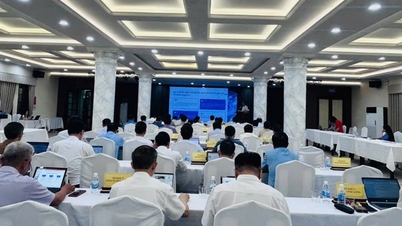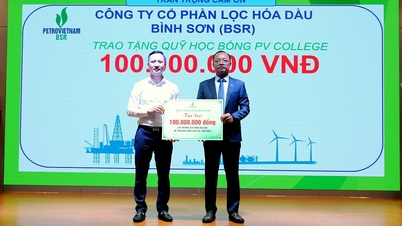According to the Organization for Economic Cooperation and Development (OECD), labor productivity is the value of final goods and services created by a unit of labor in the production process. In Vietnam, this indicator is calculated by the average gross domestic product (GDP) per working worker in the year, directly reflecting the efficiency of labor use and the technological level of the economy.
After nearly 40 years of renovation, Vietnam has made great strides in productivity and economic efficiency. From a backward agricultural country, Vietnam has now become one of the countries with the fastest growth in labor productivity in Asia.
According to statistics, in 2024, labor productivity of the entire economy will reach 221.9 million VND/worker, equivalent to 9,182 USD/worker, an increase of more than 726 USD compared to 2023. In the period 2010-2024, Vietnam's labor productivity increased more than 3.9 times, from 56 million VND to nearly 222 million VND. The average growth rate is about 5.05%/year, and in 2024 alone it will reach 5.88%, exceeding the target assigned by the National Assembly .
Behind that impressive figure is a strong economic restructuring, a wave of investment in technology, and the maturity of a young, dynamic workforce, ready to adapt to new technology. The quality of human resources is increasingly improved: The rate of trained workers increased from 64.5% in 2020 to an expected 70% in 2025, of which the rate with degrees and certificates reached nearly 30%.

Labor productivity - A measure of Vietnam's competitiveness in the digital age.
In particular, the business sector has become the "locomotive" leading productivity. Although accounting for only about 29% of the workforce, this sector generates up to 60% of the GDP of the whole economy. Of which, the FDI sector contributes about 20% of GDP, private enterprises about 10% and state-owned enterprises nearly 30%. The participation of businesses in the global value chain, along with the application of digital technology, has created a strong driving force for increasing productivity and quality of "Make in Vietnam" products.
Despite many advances, Vietnam’s labor productivity is still not commensurate with its potential, still far behind developed economies in the region. According to estimates, Vietnam’s labor productivity is only about 11% of Singapore’s, 26% of Malaysia’s and 40% of Thailand’s.
The three main reasons for slow productivity growth include:
Firstly , many businesses, especially small and medium enterprises (SMEs), are still hesitant to invest in technology due to high costs, high risks and lack of information. The "fear of innovation" mentality still exists, causing the transition to modern production to be slow.
Second , management and innovation capacity is still limited. Many businesses have not yet formed an internal innovation culture and lack mechanisms to encourage initiatives and inventions, leading to productivity growth mainly based on cheap labor instead of knowledge and technology.
Third , the lack of skills and investment capital is a major barrier. Many workers are not equipped with digital skills, technology skills and foreign languages to adapt to the modern production environment. Small businesses have difficulty accessing credit capital to invest in technology, digital transformation and research and development (R&D).
In the context of Vietnam identifying science, technology, innovation and digital transformation as three pillars of socio-economic development, improving labor productivity needs to be approached as a comprehensive national strategy. It is necessary to perfect the institutional framework and policies to encourage the transformation of the growth model from breadth to depth, focusing on productivity, quality and efficiency. At the same time, create a favorable environment for creative startups, promote research and commercialize scientific and technological results. Strong administrative reform and decentralization combined with increased accountability help businesses easily access programs to support innovation, digital transformation and high-tech application.
Enterprises need to consider productivity as a survival strategy, the top criterion in development planning. To do so, it is necessary to boldly invest in technology, promote comprehensive digital transformation from production, management to distribution. Applying advanced management models (ERP, Lean, 6 Sigma, ISO 56000...) and exploiting big data (Big Data, AI, IoT) will help optimize processes, reduce costs, and increase added value. At the same time, building a culture of innovation encourages employees to propose ideas and improve products, thereby improving productivity from within human resources.
In the digital age, productivity is not just about “doing more,” but “doing smarter.” Each person needs to proactively improve their vocational skills, digital skills, creative thinking, and lifelong learning abilities.
Discipline, industrial style, sense of responsibility and learning awareness are key factors to help workers increase personal productivity, affirm their value and income in the knowledge economy.
The world is entering the era of knowledge-based productivity, where technology, innovation and data become "new resources". For Vietnam, this is a golden time to make a breakthrough, when policies on national digital transformation, science and technology development and the innovation ecosystem have been clearly shaped.
Increasing labor productivity will not only help Vietnam narrow the development gap, but also create a foundation for the transition to a green, sustainable and self-reliant growth model. By harmoniously combining technology, institutions and people, Vietnam can completely build a highly productive economy where every working hour brings knowledge, creativity and efficiency.
Source: https://mst.gov.vn/nang-suat-lao-dong-thuoc-do-nang-luc-canh-tranh-cua-viet-nam-trong-ky-nguyen-so-197251014100532369.htm




























![[Photo] Ready for the 2025 Fall Fair](https://vphoto.vietnam.vn/thumb/1200x675/vietnam/resource/IMAGE/2025/10/14/1760456672454_ndo_br_chi-9796-jpg.webp)












































![[Photo] General Secretary To Lam chairs the meeting of the Central Steering Committee on science, technology development, innovation and digital transformation](https://vphoto.vietnam.vn/thumb/402x226/vietnam/resource/IMAGE/2025/10/15/1760500443782_anh-man-hinh-2025-10-15-luc-10-52-47.png)






























Comment (0)